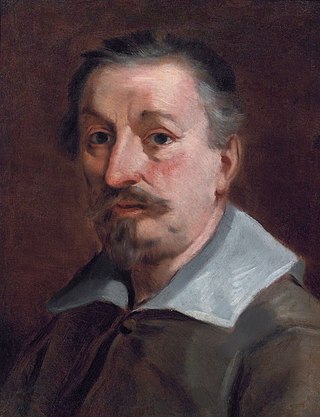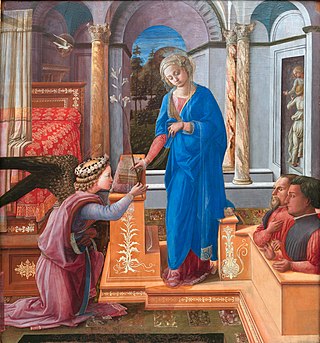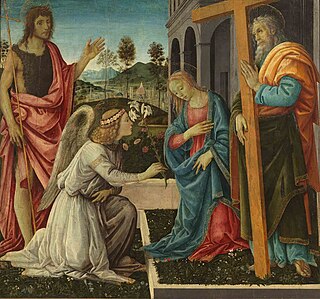
Filippino Lippi was an Italian Renaissance painter mostly working in Florence, Italy during the later years of the Early Renaissance and first few years of the High Renaissance. He also worked in Rome for a period from 1488, and later in the Milan area and Bologna.

Filippo Lippi, also known as Lippo Lippi, was an Italian Renaissance painter of the Quattrocento and a Carmelite priest. He was an early Renaissance master of a painting workshop, who taught many painters. Sandro Botticelli and Francesco di Pesello were among his most distinguished pupils. His son, Filippino Lippi, also studied under him and assisted in some late works.

Francesco Albani or Albano was an Italian Baroque painter of Albanian origin who was active in Bologna, Rome, Viterbo (1609–1610), Mantua (1621–1622) and Florence (1633).

Paris Bordone was an Italian painter of the Venetian Renaissance who, despite training with Titian, maintained a strand of Mannerist complexity and provincial vigor.

The Galleria Doria Pamphilj is a large private art collection housed in the Palazzo Doria Pamphilj in Rome, Italy, between Via del Corso and Via della Gatta. The principal entrance is on the Via del Corso. The palace façade on Via del Corso is adjacent to a church, Santa Maria in Via Lata. Like the palace, it is still privately owned by the princely Roman family Doria Pamphili. Tours of the state rooms often culminate in concerts of Baroque and Renaissance music, paying tribute to the setting and the masterpieces it contains.

The Galleria Nazionale d'Arte Antica or National Gallery of Ancient Art is an art museum in Rome, Italy. It is the principal national collection of older paintings in Rome – mostly from before 1800; it does not hold any antiquities. It has two sites: the Palazzo Barberini and the Palazzo Corsini.

The Villa Doria Pamphili is a seventeenth-century villa with what is today the largest landscaped public park in Rome, Italy. It is located in the quarter of Monteverde, on the Gianicolo, just outside the Porta San Pancrazio in the ancient walls of Rome where the ancient road of the Via Aurelia commences.

The Annunciation is an Italian Renaissance painting by Filippo Lippi. Dating to 1440–1445, it is housed in the Galleria Nazionale d'Arte Antica of Palazzo Barberini, Rome.

Marcello Venusti was an Italian Mannerist painter active in Rome in the mid-16th century.

The Enthroned Madonna and Child is a painting by the Italian Renaissance painter Filippo Lippi. It is housed in the Galleria Nazionale d'Arte Antica of Palazzo Barberini, Rome.

Olimpia Aldobrandini was a member of the Aldobrandini family of Rome, and the sole heiress to the family fortune.

The Annunciation, also known as Murate Annunciation, is a painting by the Italian Renaissance painter Filippo Lippi, finished around 1443–1450. It is housed in the Alte Pinakothek, Munich, Germany.

Camillo Francesco Maria Pamphili was an Italian Catholic cardinal and nobleman of the Pamphili family. His name is often spelled with the final long i orthography; Pamphilj.

The Coronation of the Virgin is a painting of the Coronation of the Virgin by the Italian Renaissance master Filippo Lippi, in the Uffizi, Florence.

The Annunciation is a painting by Fra Filippo Lippi hung in the Martelli Chapel in the left transept of the Basilica di San Lorenzo, Florence, Italy. There are several paintings by Lippi of this same name.

The House of Doria Pamphilj Landi was a princely Roman family of Genoese extraction. Legend has it that the origins of the Doria family date from the early 11th century, but the authentic pedigree is traced to Ansaldo d'Oria, consul of Genoa in the 12th century. The descent of the several Doria family lines in Genoa is well-known and is described in Natale Battilana's 19th-century genealogical study of old Genoese families.

The Annunciation is a tempera on panel painting by the Italian Renaissance master Filippo Lippi, dating to c. 1449–1459, in the collection of the National Gallery, London. It is a pendant to Lippi's Seven Saints, also in the National Gallery. The lunettes were commissioned as part of the decoration of the Palazzo Medici in Florence, where they were likely placed above a door or a bed.

Domenico di Zanobi, formerly known as the Master of the Johnson Nativity, was an Italian Renaissance painter. His exact dates of birth and death are not known. He is documented as a mature artist from 1467 until 1481.

Annunciation with St John the Baptist and St Andrew is a c.1485 oil-on-panel painting by Filippino Lippi. An early work by the artist, it shows an Annunciation scene between John the Baptist and Andrew.

The Massa Fermana Altarpiece is a 1468 tempera and gold on panel by the Italian painter Carlo Crivelli, held in Santi Lorenzo e Silvestro church in the town of Massa Fermana. It is signed "KAROLVS CRIVELLVS VENETVS PINXIT HOC OPVS MCCCCLXVIII". It is his earliest known surviving work and is notable for dating his return to Italy.




















